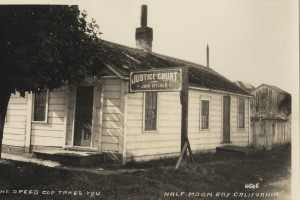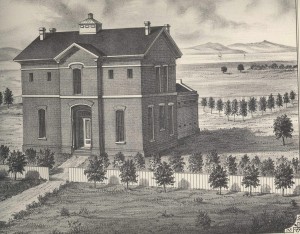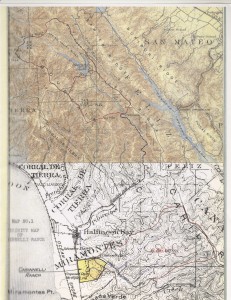This is a wonderful drawing of the county jail in Redwood City, circa 1872. Has some institutional feel to it but it also looks like a country home; what do you think?
From “The Illustrated History of San Mateo County,” Moore & DePue, publishers (1878). This beautiful book was “saved” and published by Gilbert Richards Publications, Woodside, California in 1974.
In Half Moon Bay, if you were caught speeding you’d land in Judge Pitcher’s “courtroom.” 
Look on the map below and find the land, Casinnelli Ranch; it’s colored yellow and there’s an arrow pointing to it, below the “Miramontes tract.” In an earlier WWII post, I mentioned Mr. E.J. Casinnelli as he owned 423 acres around the Johnston House.
In 1931, the Cassinelli Ranch, south of Half Moon Bay, was being considered as a location for San Francisco’s City and County Jail in San Mateo County. There are several documents associated with the project that did not materialize. Some people will find the information contained within the reports enlightening so I will provide it here.
Report on Water Supply Possibilities of Cassinelli Ranch as a site for San Francisco City and County Jail
By Charles H. Lee, Consulting Hydraulic Engineer
Description of Property
The Cassnelli Ranch, comprising 423 acres, is located in San Mateo County, California, one mile south of Half Moon Bay. The west boundary fronts on the Half Moon Bay-Purissima Highway for a distance of over 1/2 mile. A surfaced road from the main highway runs along or adjacent to the north boundary for 3/4 miles.
The western portion of the property, embracing approximately 200 acres, is flat land lying along the main highway. It merges into gently sloping land and then broad rolling hill slopes to a crest at the rear of the property. The topography is smooth and practically all of it is clear of brush, giving excellent visibility.
All but a small tract in the northeast corner has been under cultivation for many years. A portion of the flat land has been planted in artichokes and miscellaneous vegetables, and the remainder and the adjacent hill land in hay and grain. The artichokes are irrigated every season and vegetables when water is available.
Leon Creek flows through the Ranch near the northeast boundary for a distance of 3095 feet, where it has a cut channel approximately 35 feet deep and 100- to 200 feet wide. This stream is a tributary of Pilarcitos Creek, joining it at Half Moon Bay about 1-1/4 miles below the Ranch and flowing thence to the Pacific Ocean, a distance of 1-1/4 miles.
Water Rights
The Cassinelli Ranch is an unsubdivided portion of the Miramontes Land Grant. Pilarcitos Creek bounded this grant on the north and Leon Creek flowed through it, both streams being riparian to the Grant. Cassinelli Ranch has never been severed from Leon Creek and has full riparian rights in its flow.
The ranch also has an appropriative right in the flow of Leon Creek (Arroyo Leon) to the extent of the 60 miners inches measured under a 4-inch pressure (540 gallons per minute). This right was initiated June 14, 1912 in accordance with the Civil Code requirements by the posting and recording of a Notice of Appropriation, copy of which accompanies this report as Exhibit No. 1. This right was perfected and has been maintained to date by the construction of permanent concrete dams in Leon Creek and the diversion and use of water therefrom for domestic and stock purposes and the irrigation of valuable crops.
The original notice specified that after such use on the Cassinelli Ranch, the remainder was to be used on the tract of land lying to the north and downstream, now known as the Johnston Ranch. In accordance of this provision, water has been used for irrigation on the Johnston Ranch, diversion being made at both the Cassinelli Dam and a lower dam constructed on the property for this purpose. Water has also been diverted from the Cassinelli Dam for irrigation of the Monte Valda Ranch which lies immediately to the north. Water is diverted by means of horizontal belt connected electric motor operated centrifugal pumps, the total diversion capacity being as follows.
Cassinelli Dam to Cassinelli Ranch, 2″ Byron Jackson Pump – 125 g.p.m.
Cassinell Dam to Monte Valda Ranch, 3″ Monarch Pump – 225 g.p.m.
Johnston Dam to Johnston Ranch, 3: Monarch Pump -225 g.p.m.
Total = 575 g.p.m.
Diversion under this appropriation commenced in 1912 or 1913, and it is understood by the writer, has been continuous to date. According to the statement of Mr. E.J. Cassinelli, who operates all three properties, all water was diverted and used throughout the irrigation season during the last pat five years and previously, none being allowed to escape from the lower dam to flow downstream. He also states that during part or all of the irrigation season of every year for more than five years last past, all the flow of Leon Creek has been diverted and used upon Cassinelli Ranch when needed.
The two diversion dams have been built to a height sufficient to create stream bed storage reservoirs. In addition to direct flow diversion, there has been a considerable volume of winter flow impounded each year in these reservoirs. The capacity of the reservoir on Cassinelli Ranch, with flashboards in place closing the spillway, is approximately 3, 400,000 gallons. The reservoir is filled to this capacity every year at the commencement of the irrigation season. Storage water has been diverted and used upon the three properties for more than five years last past, commencing first in 1912 or 1913. The reservoir on the Johnston Ranch is of slightly less capacity and has been similarly used.
To summarize, the Cassinelli Ranch has the right to divert to the full flow of Leon Creek up to 60 miners inches or 777,600 gallons per day when available and needed. It also has the right of a riparian owner to impound the flow of Leon Creek on the property for use thereon and has actually been so impounding at least 3,400,000 gallons for at least five years last past.
Developed Water Supply
The quantity of water at present (1930) being developed from Leon Creek under the water rights appurtenant to Cassinelli Ranch can be estimated from the acreage irrigated on the Cassinelli, Johnston, and Monte Valda Ranches. Mr. E. J. Cassinelli states that he irrigates 60 acres of artichokes and 20 acres, ore or less, of vegetables on the Cassinelli Ranch, 50 acres of artchokes on the Johnston Ranch, and 60 acres of artichokes on the Monte Valda Ranch. The total area planted in artichokes averages 170 acres. The irrigation season extends from June 1 to October 15. In the normal runoff years, with the present diversion and storage facilities, there is sufficient water for irrigation of this acreage during the ordinary irrigation season. In dry years there is not sufficient to irrigate vegetables, and in very dry years it is necessary to cut down the artichoke area to approximately 125 acres. The reservoir outlet gates are usually closed about April 15, the flashboards placed in the spillway about June 1, and the irrigation season commenced with full reservoirs. The flow of the stream is normally sufficient to supply all pumps for some time after June 1. The stream normally has a substantial flow until July 15, but in dry years this date is advanced to about July 1. Water is pumped 12 hours per day and water is impounded night and Sunday.
A 2 inche Byron Jackson pump raises water from the upper reservoir for irrigation on the Cassinelli Ranch. This pump, with a capacity of 125 gallons per minute, and operating 12 hours per day, June 1 to October 15, exclusive of Sundays, delivers 10,600,000 gallons. This represents a duty of water 1/2 acre foot per acre as applied to 60 acres of artichokes. At this same rate the 110 acres of artichokes on the Johnston and Monte Valda Ranches, as irrigated from the two reservoirs, receive during each season 17,900,000 gallons, giving a total net supply of 28,500,000 gallons. This presents 208,000 gallons per day average for 137 days from June 1 to October 15.
In a very dry year the combined supply from stream-flow and storage during the irrigation season, as used on 125 acres, is similarly estimated at 21,000,000 gallons or 153,000 gallons per day.
Water is not ordinarily diverted from Leon Creek for use during the non-irrigation season except to fill the reservoirs.
Available Water Supply
The maximum dependable supply which can be developed form Leon Creek for use on Cassinelli Ranch property under its existing water rights is the total annual runoff in the dryest year less that to which the owners of piror and vested rights are entitled, and further limited by the storage and diversion facilities which can be provided.
Runoff of Leon Creek. The watershed of Leon Creek above Cassinelli Dam comprises 6.86 square miles of steep grassy and bushy hill slopes reaching to the crest of the Coast Range at an elevation of 1500 feet and along which it extends for a distance of two miles. Average annual rainfall varies from 25 inches near the Coast to 40 inches at higher elevation. Extreme shortages of seasonal rainfall exceding 50% are of record in this region.
The direct exposure of Leon Creek to storms from the Pacific Ocean and the prevalence of heavy fogs during the summer are both favorable to higher rates of runoff than from watersheds draining the east slope of the Coast Range. Storm runoff, even though held back by luxuriant growth of grass and brush, sometimes exceeds the capacity of the 6 x 7 foot sluice gte throug the Cassinelli Dam. One night’s storm in the early part of the year is frequently sufficient to fill the reservoir.
As indicated by the following date, ample water flows in the stream to fill both Cassinelli and Johnston Reservoirs many times over prior to June 2, even in the dryest year. The present year is one of unusual rainfall shortage, the percent of normal rainfall to date being 59%. The flow of Leon Creek on March 9, 1931, forty-five days aftr the last previous storm of any size, is reported by the City Engineer’s Office as 200 gallons per minute or 288,000 gallons per day. The flow March 21, nine days after the storm of March 11-12, as measured by the writer, was 450 gallons per minute or 648,000 gallons per day. The flow as measured by the City Engineer’s Office, would have completely filled Cassinelli Reservoir in about 17 days. The larger flow on March 21 would have filled it in less than six days. The ranch forman states that frequently the flow during a single storm is more than sufficient to fill the reservoir.
The records of the State Department of Public Works, as compiled by the State Engineer, indicate that the minimum annual runoff of Bolinas Creek and adjacent coast streams whose watersheds have less rainfall than Leon Creek, is 48 acre feet per square mile. The equivalent runoff for Leon Creek watershed would be 329 acre feet or 107,000,000 gallons. This is 31 times the capacity of the Cassinelli Reservoir. With storage facilities, and after deducting 25% for losses, this would produce an average daily gross supply of 220,000 gallons. Because of the greater rainfall on Leon Creek watershed, this amount is probably much less than the actual minimum runoff. The same records indicate that runoff in a normal year is from five to ten times that in a minimum year.
All available records and the statements of Mr. E.J. Cassinelli, who has been in constant touch with water conditions Cassinelli, who has been in constant touch with water conditions on Leon Creek for the past fifteen years, indicate that even in the dryest year there is ample water flowing in Leon Creek during the winter season to fill Cassinelli Reservoir many times.
Prior and Vested Rights. All downstream riparian landowners have been stopped from asserting their claims by the adverse prescriptive diversion of water under the Cassinelli Ranch appropriation for more than five years last past.
Possible upstream uses by riparian owners are limited to a very small acreage by the steep topography of the country which closes down to a narrow canyon immediately above the upper boundary of the Cassinelli property. There are at present three or four pump diversions from the stream, the lowest using water for domestic and stock purposes and the irrigation of 5 to 10 acres of land. Other diversions are for domestic and stock use and possibly small gardens. There are, in all, ten or eleven families living along the stream. The total upstream riparian use can never greatly exceed that at present.
Supply with Existing Storage Facilities. The Cassinelli Dam has storage capacity of 3,400,000 gallons. In a dry year when the stream is reduced to a small flow by July 1, storage water in the reservoir would be the only supply until winter rains in December caused a resumption or stream-flow. Deducting for evaporation at the rate of five inches per month during the summer, this would yield an average supply of approximately 17,000 gallons per day. During the remainder of the year there would be ample flow in the stream to supply all needs.
Supply with Proposed Storage Facilities. There are two possible storage sites on Cassinelli Ranch which can be developed inexpensively for storage of winter runoff from Leon Creek. One of these sites is on the creek channel just above the existing reservoir. By construction of a small dam of earth or concrete at this point, a reservoir will be created of capacity about equal to that of the existing reservoir. This additional storage would double the supply available in a dry year, producing approximately 34,000 gallons per day.
A much larger site, however, is available on the property in the first large canyon south of Leon Creek. This site lies at an elevation of between 150 and 200 feet above sea level. An earth dam 14 feet high and approximately 370 feet long has already been constructed, which provides a storage capacity of at least 5,000,000 gallons. When first filled, the dam settled for a width of about 15 feet above the old stream bed, and a channel of this width was washed out through the dam, and down to firm clay. The dam can easily be repaired and raised 3 or 4 feet with present slopes, giving a capacity of approximately 7,000,000 gallons. Deducting for evaporation, a reservoir of this capacity would provide a supply of 40,000 gallons per day during a dry year.
The site would permit of raising the dam at least 20 feet above the present level, and this could be accomplished at very reasonable cost. With such a height, a storage capacity of at least 15,000,000 gallons would be created. This would provide a net supply of at least 90,000 gallons per day in a dry year, which combined with the yield of 34,000 gallons per day from Cassinelli Dam and the proposed upper dam on Leon Creek, would furnish a total supply of 124,000 gallons per day. This supply could be further increased to 130,000 gallons per day by storage in an existing reservoir in a small ravine between Leon Creek and the proposed reservoir at an elevation of 100 and 150 feet above sea level. In normal years the supply would be much greater.
The existing reservoir on Leon Creek can be operated very advantageously as a temporary storage and settling reservoir in conjunction with the large reservoir to the south. The latter has a very small tributary drainage not exceeding 100 acres, all of which is included in the ranch property. It is probably that water from this reservoir would be potable without expensive treatment. The pumping life from Cassinelli Dam is between 75 and 100 feet, and the pipeline distance is 2150 feet. For a pump capacity of 225 gallons per minute, which would fill the reservoir at ultimate capacity in 45 days, a 6 inch pipeline would be of ample size.
The recommended program of development would be to at once repair the existing earth dam, raise it 4 or 5 feet, and lay the pipeline from Cassinelli Dam. These facilities would provide an ample domestic supply for more than one thousand inhabitants at the jail, which would probably be sufficient for 5 or 10 years. Later the earth dam could be raised progressively as desired, and, if necessary, additional storage be provided on Leon Creek. The water development can thus be made progressively and without great expense, and ultimately would be adequate to supply the needs of at least 2000 inhabitants.
Reserve Supply from Pilarcitos Reservoir. It is possible to deliver water to Cassinelli Ranch by gravity pipeline from the existing Pilarcitos Reservoir now owned by the City and County of San Francisco. The pipeline distance from Stone Dam down Pilarcitos Creek to the highway and thence via Half Moon Bay to the Ranch, is 7 miles. The available head is such that a 4 inch pipeline would deliver more than 100,000 gallons per day by gravity flow. Such a line could be quickly laid and would always represent a reserve which could be drawn upon in case of emergency.
—end—


